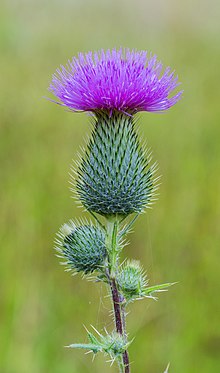Cirsium vulgare
| Cirsium vulgare | |
|---|---|

| |
| Plant in flower, Joure, Netherlands | |

| |
| Seedhead | |
| Scientific classification | |
| Kingdom: | Plantae |
| Clade: | Tracheophytes |
| Clade: | Angiosperms |
| Clade: | Eudicots |
| Clade: | Asterids |
| Order: | Asterales |
| Family: | Asteraceae |
| Genus: | Cirsium |
| Species: | C. vulgare
|
| Binomial name | |
| Cirsium vulgare | |
| Synonyms[1] | |
|
Synonymy
| |
Cirsium vulgare, the spear thistle, bull thistle, or common thistle, is a species of the
The plant provides a great deal of
Description
It is a tall
Ecology
Spear thistle is often a
Weed status
Spear thistle is designated an "injurious weed" under the UK Weeds Act 1959,[18] and a noxious weed in Australia[17][19][20] and in nine US states.[21] Spread is only by seed, not by root fragments as in the related creeping thistle C. arvense. It is best cleared from land by hoeing and deep cutting of the taproot before seeds mature; regular cultivation also prevents its establishment.[13]
Despite this label, the plant has beneficial qualities beyond its very high
Other names
Common names include bull thistle,[13][22] Scots, Scottish, or Scotch thistle, and common thistle.[22]
Uses
The stems can be peeled (removing their spiny surfaces) and then steamed or boiled.[11] The tap roots can be eaten raw or cooked, but are only palatable on young thistles that have not yet flowered.[23] The dried florets steeped in water are used in rural Italy for curdling goats' milk in preparation for making cheese.[citation needed]
In culture
The plant features in some Scottish ceremonies such as the "Riding of the Marches", held annually in Langholm in July. The 1992 specimen measured six feet in length[24]
Spear thistle is also the emblem of Newton Regis in England.[24]
References
- ^ The Plant List, Cirsium vulgare (Savi) Ten.
- ^ Flora Europaea: Cirsium vulgare
- ^ Den Virtuella Floran: Cirsium vulgare (in Swedish, with maps)
- ^ Altervista Flora Italiana, Cardo asinino, Cirsium vulgare (Savi) Ten.
- ^ Flora of China, 翼蓟 yi ji, Cirsium vulgare (Savi) Tenore
- ^ Flora of North America, Bull or common or spear thistle, gros chardon, chardon vulgaire ou lancéolé, piqueux, Cirsium vulgare (Savi) Tenore
- ^ Atlas of Living Australia, Cirsium vulgare (Savi) Ten., Black Thistle
- ^ Conservatoire et Jardin botaniques & South African National Biodiversity Institute, African Plant Database, Cirsium vulgare (Savi) Ten.
- ^ "Which flowers are the best source of nectar?". Conservation Grade. 15 October 2014. Archived from the original on 14 December 2019. Retrieved 18 October 2017.
- PMID 27341588.
- ^ OCLC 244766414.
- ISBN 0-340-40170-2
- ^ a b c d e Bond, W., Davies, G., & Turner, R. J. (2007). The biology and non-chemical control Spear Thistle (Cirsium vulgare). Archived 7 November 2020 at the Wayback Machine 6pp. HDRA the organic organisation. 2006 Version
- ^ "Bull thistle". Colorado Weed Management Association. Archived from the original on 29 September 2015. Retrieved 27 September 2015.
- ^ "Cirsium vulgare (Savi) Ten". Department of Environment and Conservation. Government of Western Australia. Archived from the original on 22 March 2011. Retrieved 7 July 2011.
- ^ "Spear thistle – Cirsium vulgare". Natural England. The Plant Press. Archived from the original on 29 September 2011. Retrieved 7 July 2011.
- ^ a b "Spear thistle". Weed Australia. Australian Weeds Committee National Initiative. Archived from the original on 27 September 2011. Retrieved 7 July 2011.
- ^ Defra, UK – Farming – Wildlife and plants Ragwort and injurious weeds Archived 30 April 2007 at the Wayback Machine
- ^ "Spear Thistle". Department of Primary Industries. Victorian Government. Retrieved 7 July 2011.
- ^ "Declared Plant Policy" (PDF). Primary Industries and Resources SA. Government of South Australia. Archived from the original (PDF) on 15 March 2011. Retrieved 7 July 2011.
- ^ "USDA PLANTS Profile for Cirsium vulgare". USDA Plant Database. USDA. Retrieved 15 July 2008.
- ^ a b "Cirsium vulgare". Germplasm Resources Information Network. Agricultural Research Service, United States Department of Agriculture. Retrieved 15 December 2017.
- ^ "Cirsium". Survival and Self Sufficiency. Retrieved 9 September 2011.
- ^ ISBN 1-85619-377-2
External links
 Media related to Cirsium vulgare at Wikimedia Commons
Media related to Cirsium vulgare at Wikimedia Commons Data related to Cirsium vulgare at Wikispecies
Data related to Cirsium vulgare at Wikispecies- "Cirsium vulgare". Plants for a Future.
- "Cirsium vulgare". Calflora. Berkeley, California: The Calflora Database.
- Cirsium vulgare in the CalPhotos photo database, University of California, Berkeley
